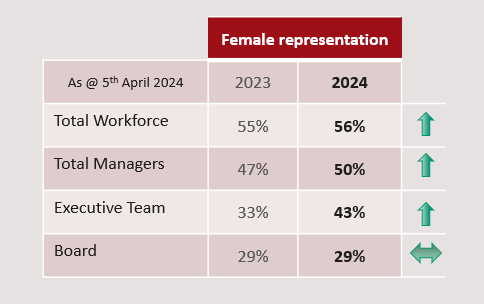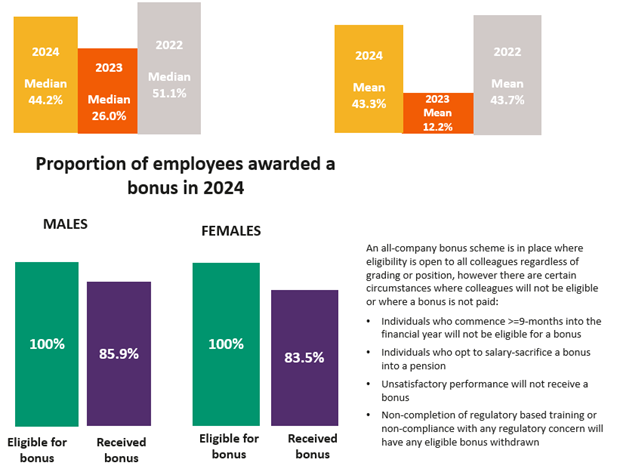
Snapshot as of 5th April 2024
Introduction
Premium Credit Limited (PCL) employs approx. 550 colleagues across the whole of the UK and Ireland and has a hybrid working model consisting of remote working and onsite collaboration with offices based in Leatherhead, Surrey and London in the UK and Dublin in Ireland. This flexibility allows our colleagues to balance work with family commitments.
Our guiding principles are to create an environment where people are treated fairly and have access to equal opportunities. We are constantly working to create a culture where people are encouraged to have diversity of thought where viewpoints, regardless of background, are considered.
In our Q4 engagement survey 85% of people stated that they feel comfortable being themselves at work and 86% said that people are respectful of each other at PCL. This has increased by 10% over the last year and reflects the work we have been doing on Inclusive Leadership. As part of our programme all managers have been trained on what it means to be an inclusive leader and the whole organisation has been trained on Dignity at Work including sexual harassment prevention. The programme was launched by an external speaker, articles were published about best practice and colleagues and executives shared their stories.
We have continued our focus on Equity, Diversity & Inclusion over the last 12 months. This has included:
We have links with a range of external organisations and continue to be signed up to the ABI Flexible Working Charter where all our roles are advertised as open to part-time and job share, promoting inclusiveness and our flexible working policy is shared on our internet to provide transparency.
This report shows the difference between the average earnings of male and female employees, regardless of role seniority. The report also reflects differences in the average bonuses earned by such employees, the percentages of male and female employees receiving a bonus, and the proportions of males and females in each pay quartile of our workforce. The report outlines for both earnings and bonus, the mean and the median gap.
The mean is calculated by adding up all the wages of employees in a company and dividing that figure by the number of employees. This means the final figure can be skewed by a small number of highly paid individuals. The median is the number that falls in the middle of a range when everyone’s wages are lined up from smallest to largest and is more representative when there is a lot of variation in pay.
It is important to note, the Government Equalities Office define the gender pay gap as the calculated difference between average hourly earnings (excluding overtime) of men and women, as a proportion of average hourly earnings (excluding overtime) of men’s earnings. It is a measure across all jobs at Premium Credit Limited, not of the difference in pay between men and women for doing the same job.
The report outlines the gender pay gap for Premium Credit for 2024, calculated as per the regulations, at the snapshot date of 5 April 2024.
As part of our Equity, Diversity & Inclusion strategy and in accordance with the Equality Act 2010 (Gender Pay Gap Information) Regulations 2017, we publish an annual gender pay gap report.
Key Statistics
We are pleased to have our workforce comparatively represented between males and females, with females representing 56% of our workforce. 13.9% of our workforce work part-time of which 92.2% are female demonstrating our commitment to flexible working.
As at 5th April 2024 we have seen an improvement in female representation across all levels of the organisation with 50% of our managers and 43% of our executive team being female.
We are pleased to see a slight decrease in our Mean Gender Pay gap of 0.6 percentage points from 2023 and of 0.8% for the median gender pay gap at 39.6%.
This means that the median hourly earnings (excluding overtime) is 38.8% higher for males than it is for females across the organisation, or in other words the average female employee would earn 61.2p for every £1 earned by a male employee.
The positive movement in the median gender pay gap can be attributed to a few females joining the organisation in more senior manager roles as we develop our product and technology services.
We remain confident in the Company paying equal pay for equal work. We continue our efforts in reducing the gender pay gap by increasing the proportion of women in more highly paid roles and continue to focus on greater female representation in technical areas such as IT. We have started this journey with the introduction of capability frameworks and clear career pathways across the business.


Gender Split
The charts show the gender split within four equal quartiles, produced when hourly rate of pay is placed from lowest to highest. The charts also provide the median gender pay gap within each quartile.

Whilst females earn more than males in the lower two quartiles, the pay gap of males versus females in the two upper quartiles remains higher. We are pleased however that this has improved by 4.9% in the upper middle quartile since last year. Supporting females to develop their careers within the company will continue be a focus.
Gender Bonus Gap
The gender bonus gap is an equality measure that shows the difference between the average annual bonus that colleagues receive.
Based on all bonuses paid within the reporting year, the Mean and Median Gaps have increased compared to last year. The Median Gap has increased by 18.2 percentage points and the Mean Gap by 31.1%. However, this reduction was expected as some exceptional factors were reported in 2023. We are pleased to see that compared to 2022, which was a standard reporting year, the Median Gap has decreased by 6.9% and the Mean Gap has reduced by 0.4%.
As 23% of females elect to work part-time, their bonus pay will be pro-rated, thus impacting the median and mean bonus gap overall.
We recognise there is still work to do to ensure that we maintain a low gender bonus gap and we will continue our focus to develop females for more senior roles.
An all-company bonus scheme is in place where eligibility is open to all colleagues regardless of grading or position, however there are certain circumstances where bonus is not paid based on short tenure, salary-sacrifice, performance or non-compliance.

Reducing the gender pay gap continues to be a focus for the organisation and the Equity, Diversity & Inclusion Council has a clear roadmap of initiatives being rolled out in 2025 to further reduce the gap. The introduction of the Gender Balance Network in 2024 will support PCL on this journey. Our Hybrid Work model continues to support flexible working where employees can feel enabled to balance work and home lives.
Key actions in 2025 will be to:

CEO, Premium Credit Limited
20 February 2025